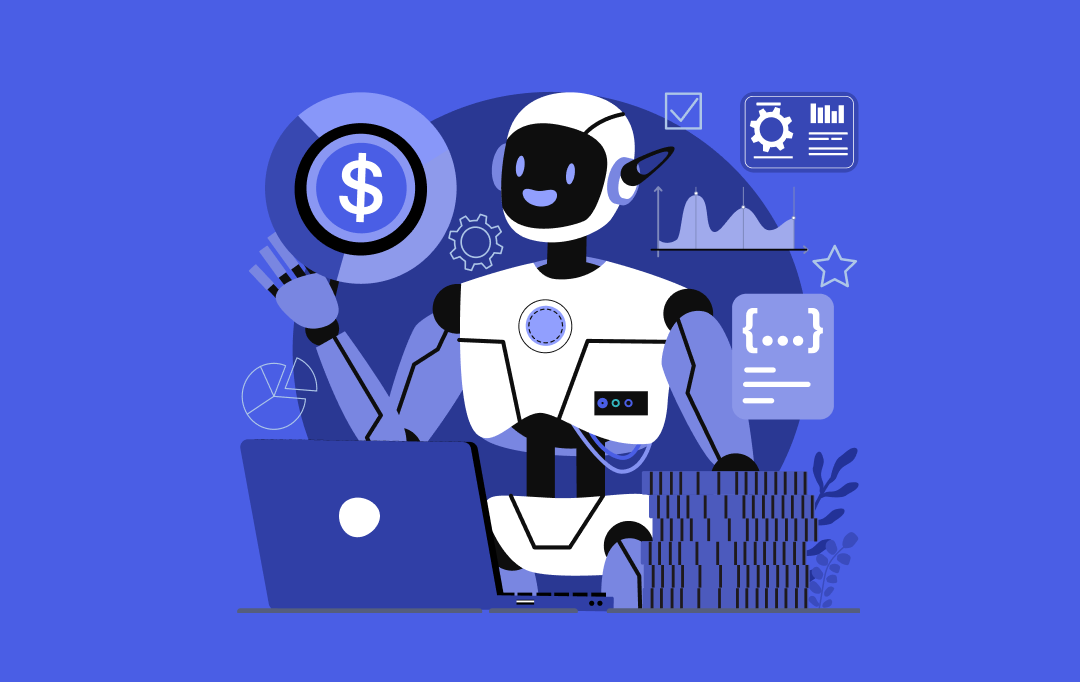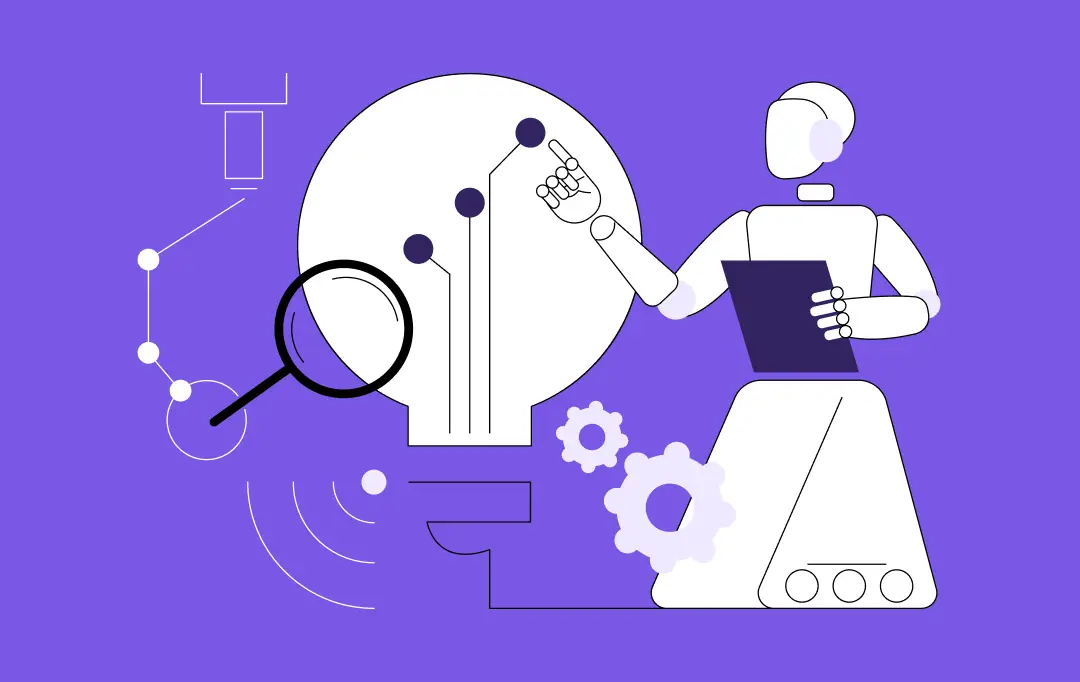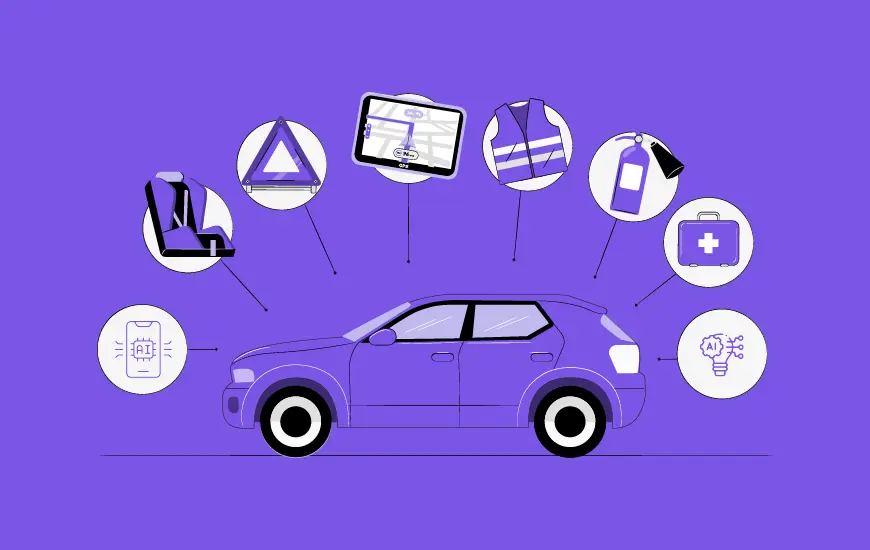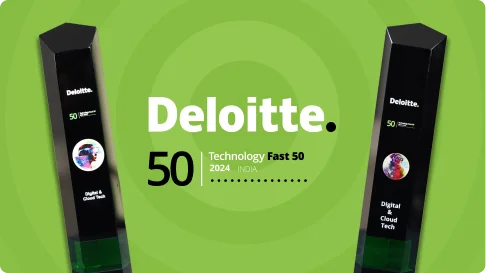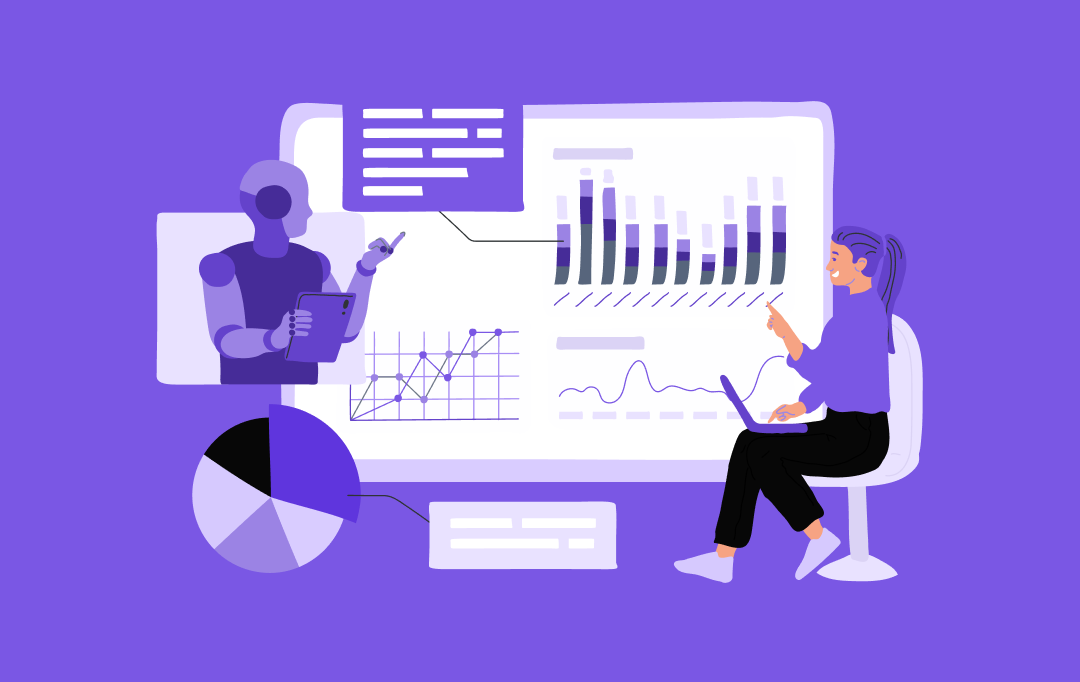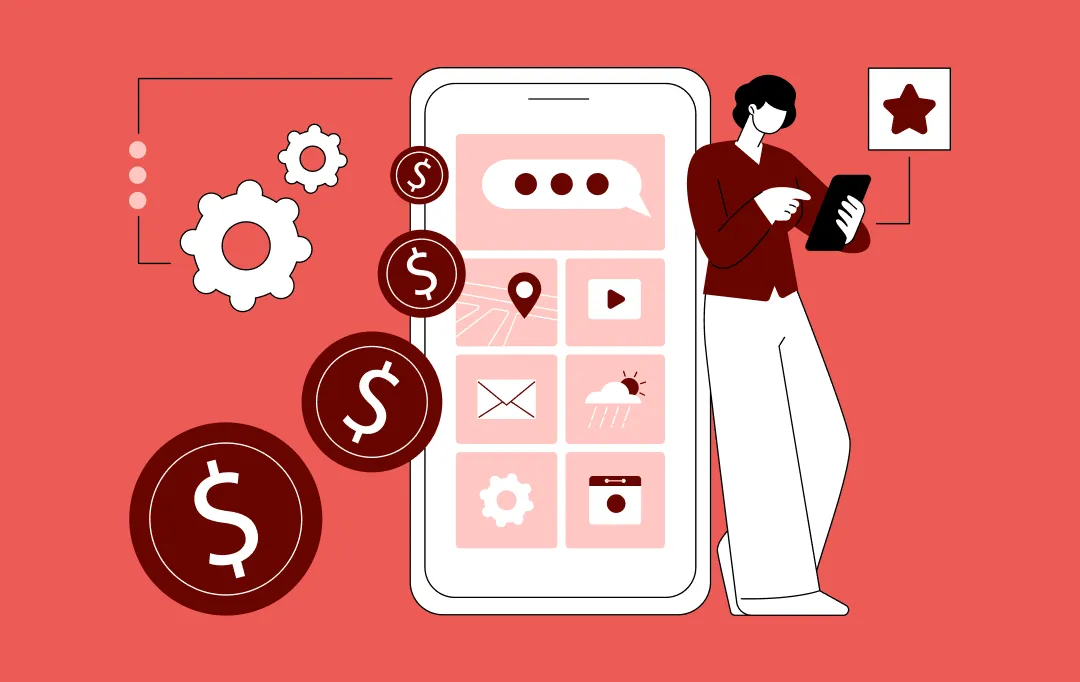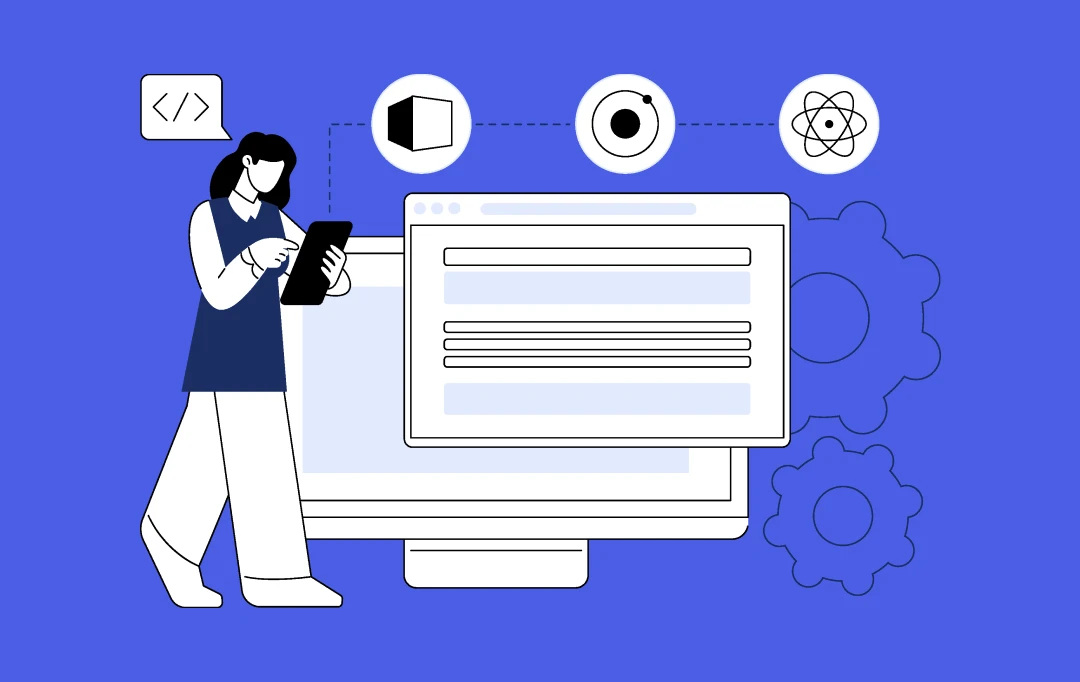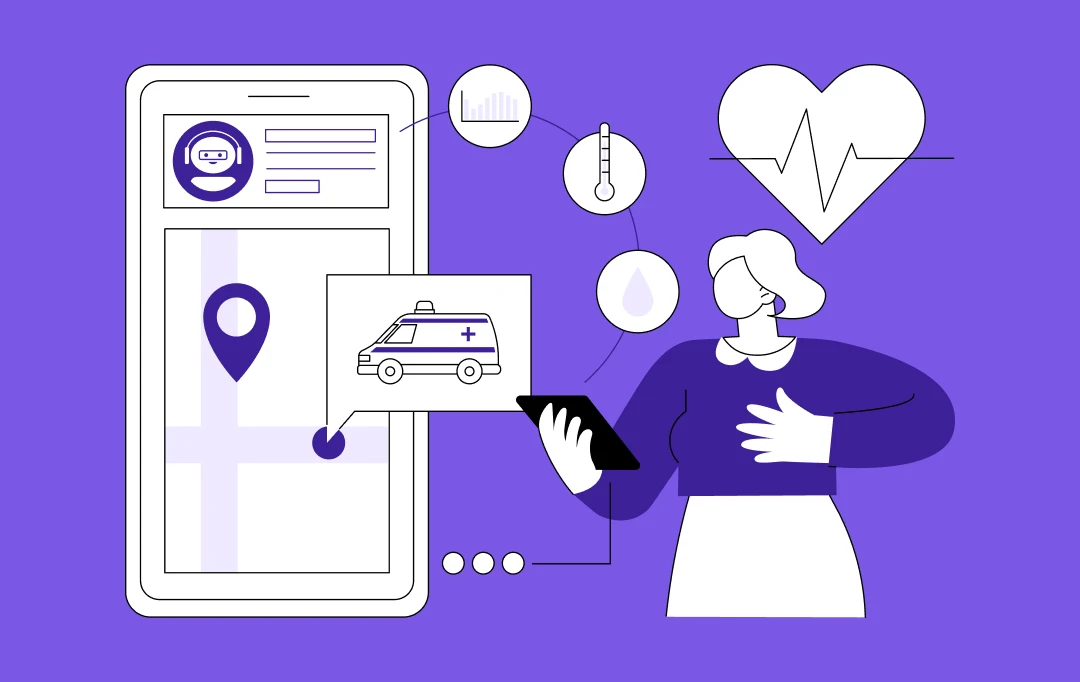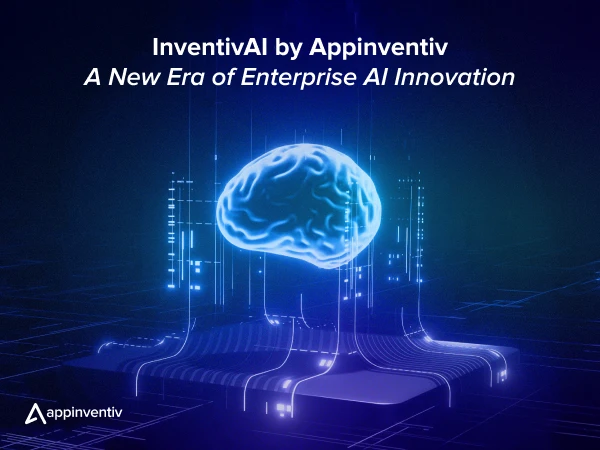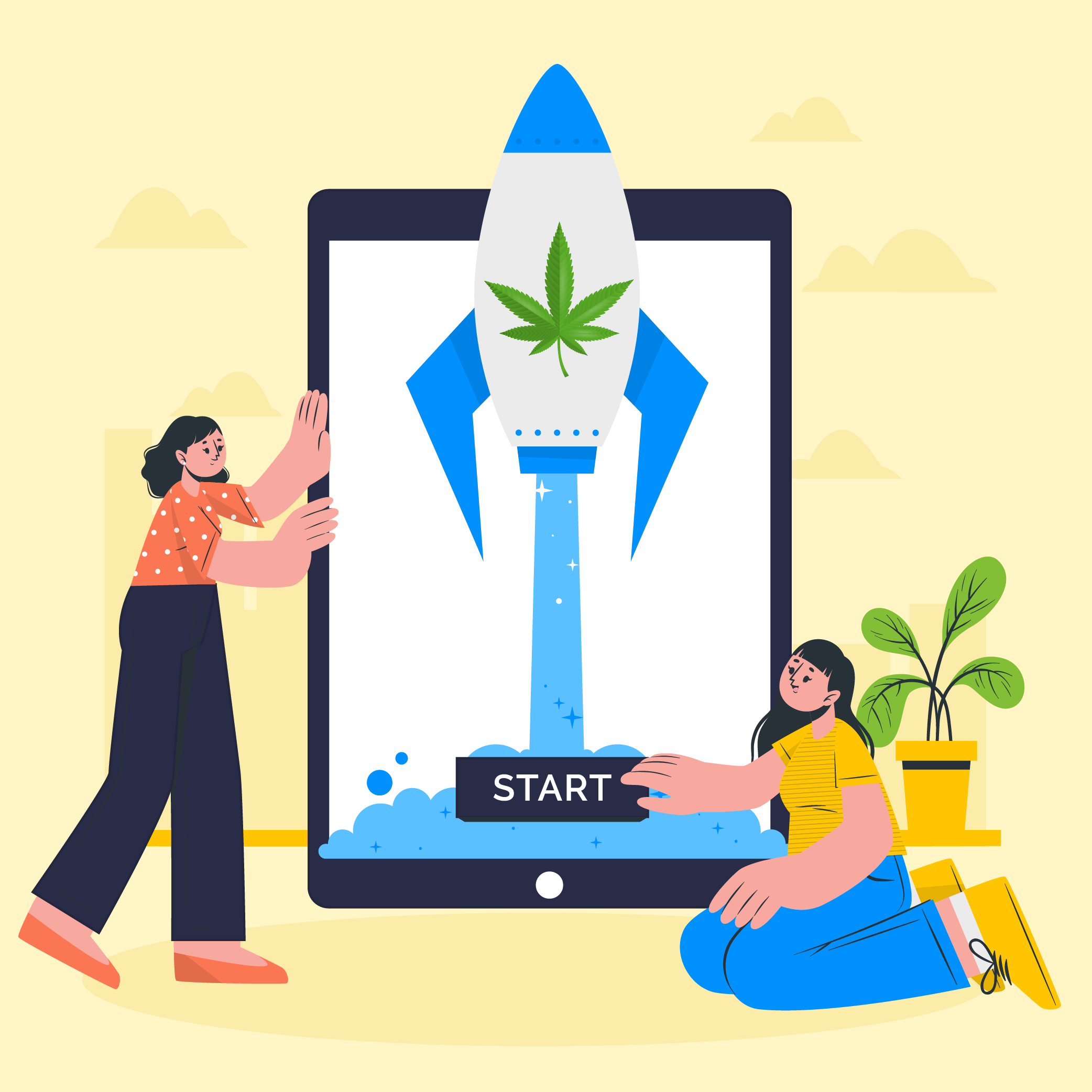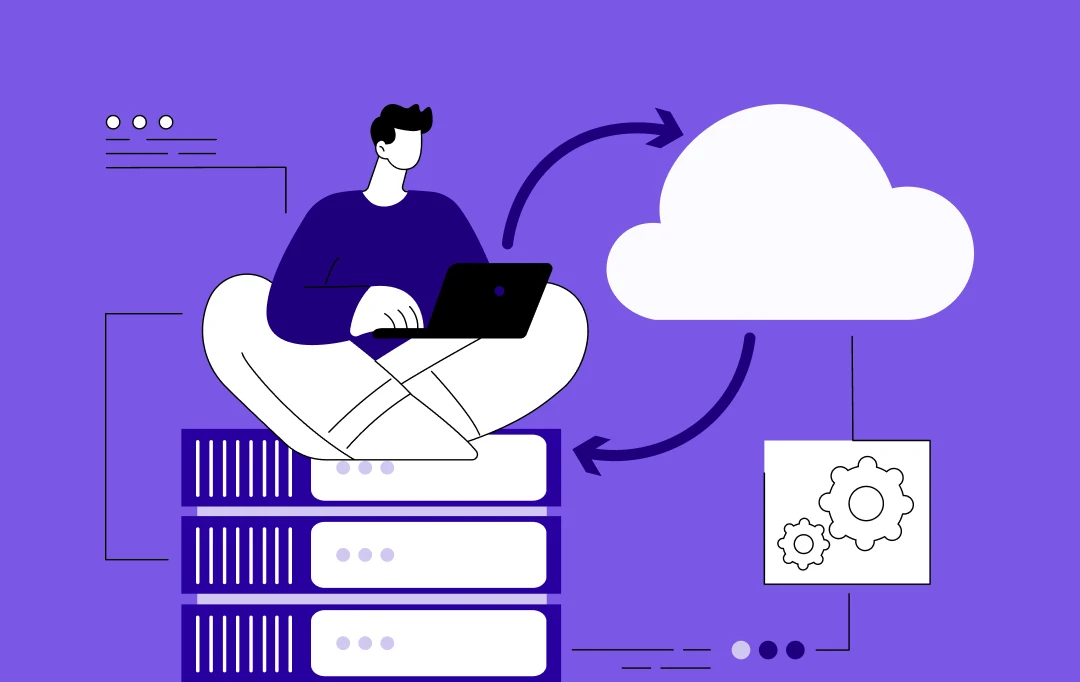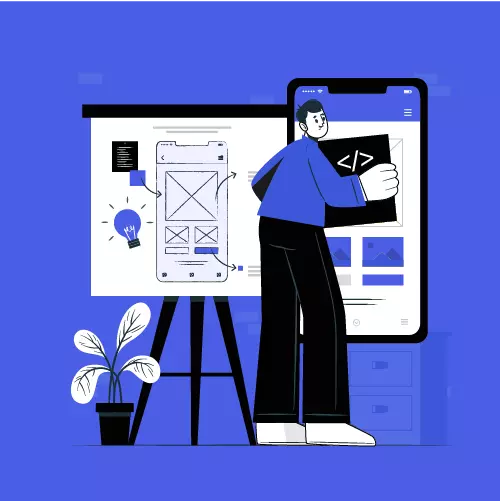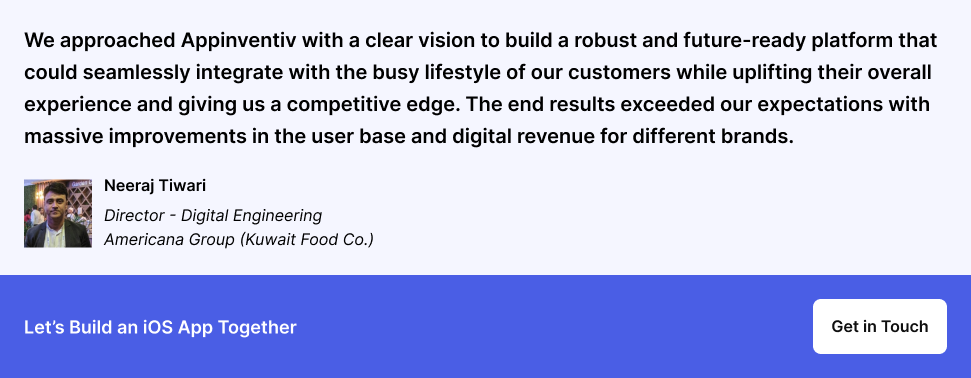- Understanding the Ecosystem of iOS App Development
- The iOS Advantage: Why Your Business Needs an Apple App
- Premium User Base and Higher Spending Power
- Strong User Loyalty and Engagement
- Device Consistency and Optimization
- Great App Speed and Reliability
- Larger User Base in the US
- Apple Users Use the Latest Version
- Enhanced Security and Privacy
- Powerful Platform
- Faster Development and Lower Maintenance
- Types of iOS Mobile App Development
- Native iOS App Development
- Hybrid Apps (Cross-Platform)
- iOS App Development Languages
- Swift
- Objective-C
- Flutter
- C#
- HTML5
- Factors to Consider before Starting to Develop iOS Applications
- Define the Purpose
- Identify Target Audience & Conduct Market Research
- Prepare a Plan
- Choose between In-house vs. Outsourcing Development
- How to Build iOS Apps for Business – A Step-by-Step Process
- Research & Strategy: The Why and What
- Design & User Experience: The Look and Feel
- Development Sprints: Building with Agility
- Quality Assurance: Polishing for Perfection
- Launch: Into the App Store
- Post-Launch Maintenance & Evolution
- From Concept to Success: Tackling iOS App Development Challenges
- Adhering to Apple’s Strict Guidelines
- Ensuring Device Fragmentation
- Managing Performance and Battery Drain
- Data Security and Privacy Concerns
- Beyond the Basics: Core Features for iOS Applications That Engage
- What Is the Cost of iOS App Development?
- How to Optimize Your iOS Mobile App Development Cost
- iOS App Development Trends to Consider in 2022 & Beyond
- Artificial Intelligence (AI) and Machine Learning (ML)
- Augmented Reality (AR) and Virtual Reality (VR)
- Internet of Things (IoT) Integration
- Cloud Integration
- Chatbots and Conversational AI
- 5G Technology Integration
- How to Choose an iOS App Development Company?
- Strong Technical Expertise
- Reputation and Reliability
- Agile Development Process
- Comprehensive Service Offering
- Communication and Collaboration
- Transparent Pricing and Contracts
- How Appinventiv Helped Global Brands Build High-End iOS Applications?
- Accelerate Your iOS App Development Journey with Appinventiv Now
- FAQs
Key takeaways:
- iOS app development offers businesses access to a premium user base with high spending power, ensuring greater potential for ROI.
- Strategic outsourcing can help optimize development costs, giving businesses access to top talent without the overhead of in-house teams.
- The cost of iOS app development varies significantly based on complexity, ranging from $40,000 for simple apps to $500,000+ for enterprise-level apps.
- Staying updated with iOS app development trends like AI, AR, and IoT ensures your app remains innovative and competitive.
Every successful business today shares one common thread: they’ve mastered the art of meeting customers where they spend their time. And increasingly, that place is iOS devices. While many companies are still debating whether mobile apps are worth the investment, smart businesses are already reaping the rewards of iOS mobile app development.
Here’s what Apple’s Official Report from June 2025 and other relevant surveys reveal about the iOS opportunity :
- $1.3 trillion in total billings and sales facilitated by the App Store ecosystem in 2024
- 1 billion+ users globally are actively using iOS apps
- 813 million weekly visitors to the App Store on average
- $406 billion generated in the US market alone in 2024
- 152% growth – the ecosystem more than doubled from $514 billion in 2019 to $1.3 trillion in 2024
- 56.63% market share held by iPhones in the US.
- 1.95 million apps currently available on the App Store (42matters)
- 1,595 new apps added daily, showing continuous growth (42matters)
- $25 billion in consumer spending during Q2 2024 alone.
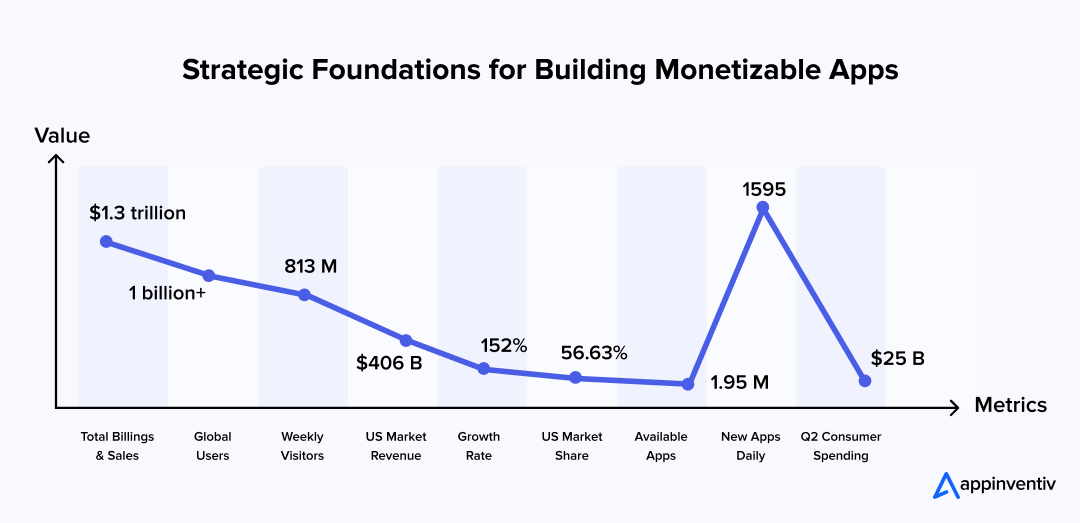
The message is clear: iOS application development isn’t just a trend. It is a dire necessity for how businesses connect with their most valuable customers. This comprehensive guide will show you exactly how to capitalize on this trillion-dollar opportunity and give actionable insights to make informed decisions about your custom iOS app development journey.
Here you will discover cost-effective strategies, emerging trends, and proven methodologies to develop iOS apps that succeed in today’s competitive marketplace.
With a proven record of developing 3000+ successful projects, we have the right expertise to help bring your vision to reality.
Understanding the Ecosystem of iOS App Development
iOS application development specifically caters to Apple’s iOS operating system. This operating system powers a wide range of Apple devices, including iPhones, iPads, and iPod Touch. The iOS ecosystem is renowned for its consistent user experience, robust security, and a rich array of functionalities.
Developing for iOS means building apps that integrate seamlessly with Apple’s hardware and software, leveraging features like Face ID, Apple Pay, Siri, and the powerful Neural Engine for on-device AI capabilities. It’s about crafting experiences that feel intuitive and “Apple-like” to a user base that appreciates design and performance.
The iOS Advantage: Why Your Business Needs an Apple App
Apple’s iOS is one of the most successful operating systems among its competitors worldwide. Here are the various reasons why you should consider developing apps for iPhone and other devices for your business.
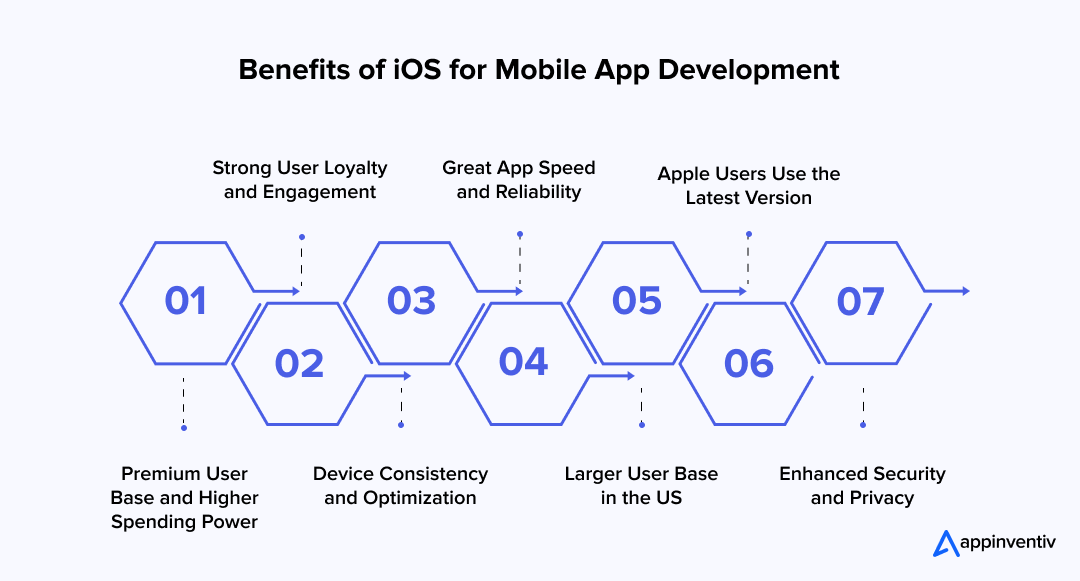
Premium User Base and Higher Spending Power
iOS users are often perceived as a more affluent demographic, and data supports this. iPhone users tend to have higher average incomes and are more likely to spend on in-app purchases and premium apps.
Strong User Loyalty and Engagement
Due to Apple’s goodwill and reputation in the market, the iOS platform has its own set of loyalists who choose the iOS app without any second thoughts. Users are deeply integrated into the Apple ecosystem, leading to higher retention rates and more frequent app usage.
Device Consistency and Optimization
Unlike Android’s fragmented device landscape, iOS offers a more standardized environment with fewer device models and screen sizes. This simplifies native iOS app development, allowing developers to optimize for a consistent experience across devices, reducing testing complexities and development time.
Great App Speed and Reliability
The iOS platform provides applications that are easy to use and have good speed, thus enhancing the user experience. Whether you have a small or large customer base, iPhone users can have the experience of a small yet feature-rich app.
Larger User Base in the US
As of November 2024, Android has a 71.42% market share worldwide. In the US, iPhones hold a market share of 56.63%. This means iOS mobile app development represents a massive opportunity for businesses looking to tap into a premium, high-spending user base.
Apple Users Use the Latest Version
The majority of Apple users run their devices on the latest version, which makes programming and development easier, as you can have a fair idea of what your app will be able to deliver. As per Apple, 88% of all devices introduced in the last four years are running iOS 18, while 81% of iPads are using iPadOS 18.
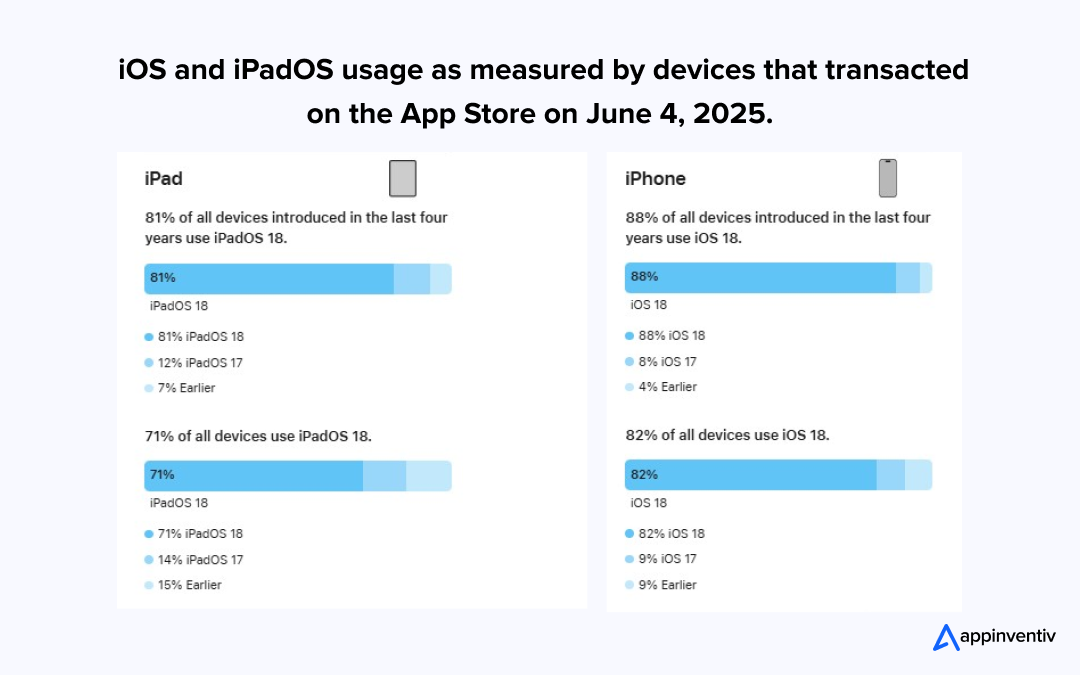
Enhanced Security and Privacy
Apple places a strong emphasis on user privacy and security. The strict App Store review guidelines and built-in security features offer a more secure environment for users, which can build greater trust in your application.
Powerful Platform
iOS is a powerful platform that helps you build user-friendly applications. The platform offers a great user experience and provides well-coded apps for users. The devices are always in sync with each other, and there are no compatibility issues.
Faster Development and Lower Maintenance
Due to the relatively fewer device variations and Apple’s comprehensive development tools and guidelines, the initial development cycle for iOS apps can sometimes be quicker than for Android. This can also lead to lower long-term maintenance costs.
Types of iOS Mobile App Development
When you decide to develop iOS apps, you generally have two main approaches: Native or Hybrid. Each has its own set of advantages and disadvantages.
Native iOS App Development
Native apps are built specifically for the iOS platform using Apple’s proprietary programming languages (Swift or Objective-C) and development tools (Xcode). They are designed to take full advantage of the device’s hardware and software capabilities.
Pros:
Superior Performance and User Experience: Native apps offer the best performance, responsiveness, and seamless integration with the device’s features. They provide the most fluid and intuitive user experience, adhering perfectly to Apple’s design guidelines.
Access to All Device Features: Full access to GPS, camera, microphone, gesture recognition, and other hardware-specific features without limitations.
Enhanced Security: Leveraging native security frameworks provides a higher level of data protection.
Cons:
Platform-Specific Codebase: You need a separate codebase for iOS and Android, meaning more development time and potentially higher costs if you need both.
Higher Development Cost (Potentially): Building two separate native apps can be more expensive than a single cross-platform solution.
When to Choose: Opt for native if your app requires high performance, complex animations, intricate device integrations (like AR/VR, IoT), or a truly unique and polished user experience. Examples include high-end games, photo/video editing tools, or apps with demanding real-time functionalities.
Also Read: Reasons Why You Should Choose Native App Development
Hybrid Apps (Cross-Platform)
Hybrid apps are built using web technologies (HTML, CSS, JavaScript) and then wrapped in a native container. Frameworks like Flutter, React Native, and Xamarin allow developers to write a single codebase that can be deployed on both iOS and Android.
Pros:
Code Reusability: A single codebase for multiple platforms significantly reduces development time and cost.
Faster Development: Quicker time-to-market due to shared code.
Lower Development Cost: Generally, more budget-friendly than building two native apps.
Cons:
Performance Limitations: May not be as smooth or fast as native apps, especially for graphically intensive applications.
Limited Access to Native Features: May require plugins or workarounds to access certain device-specific functionalities, which can sometimes lead to performance bottlenecks or bugs.
Dependency on Framework Updates: Relying on a third-party framework means you’re dependent on their updates and support.
When to Choose: Hybrid development is suitable for apps that don’t require heavy device integration, have a more content-driven nature, or when budget and speed to market are primary concerns. Examples include basic utility apps, social media feeds, or e-commerce apps with standard functionalities.
Expert Insight: For businesses looking to offer a truly premium experience and integrate deeply with Apple’s ecosystem, custom iOS app development often leans towards the native approach, providing an unparalleled user journey.
iOS App Development Languages
Once the reservations regarding how and why iOS can be helpful in your business, the next question that arises is which iOS and iPhone app development language is best for the purpose. Here is a list of some of the best iOS programming languages for both native and hybrid app development.
Swift
iOS app development in the Swift language is one of the most popular choices among businesses. It is used for building native iOS apps, is concise, and has an easy-to-use syntax. It is designed to work with frameworks such as Cocoa, Cocoa Touch, and the extensive codebase written in Objective-C for Apple products.
If you wish to develop a quick application that can be expanded later, iPhone app development in the Swift language is a good choice.
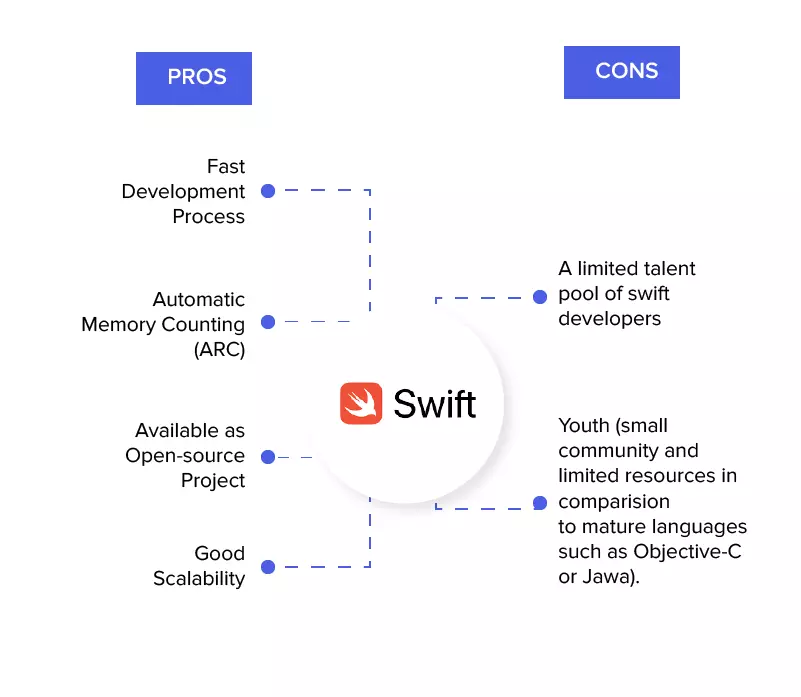
Objective-C
Objective-C was created as an extension of the C programming language. It is one of the oldest languages developed in the early 1980s by Tom Love and Brad Cox. It is a general-purpose language used for programming for Apple’s operating systems, such as OS X and iOS, and their APIs – Cocoa and Cocoa Touch.
If you wish to create an app that is compatible with the older versions of iOS that Swift does not support, Objective-C is a good choice.
Also Read: Swift vs Objective-C

Flutter
Launched in 2017, Flutter is an open-source development kit that can be used to create cross-platform apps for iOS, Android, Windows, Mac, Linux, and Google Fuchsia.
It is one of the most popular cross-platform app development languages, which is best to use if you wish to create Android, desktop, and web app versions of your iOS app.

C#
C# is a general-purpose programming language used to write applications for Windows systems. Since the .NET framework came to Linux and Mac systems, it is possible to develop native software in this language for any platform, including iOS.
C# is a good choice if you plan to create mobile apps for both iOS and Android users.

HTML5
HTML5 is the latest version of HTML, typically used in combination with CSS and JavaScript. With the help of tools such as Apache Cordova and Visual Studio for Mac, HTML5 can also be used in developing iOS applications.
HTML5 is the right programming language to consider if you do not wish to invest much time and resources and want to develop an iOS app quickly that can also be accessed offline.

Factors to Consider before Starting to Develop iOS Applications
Developing a high-performing, revenue-generating app is not an easy task. Thus, before diving headfirst into iOS mobile app development, a thorough planning phase is crucial. Addressing these factors upfront will save you time, money, and headaches down the line. Here are a few key points to keep in mind when developing iPhone and iOS apps.
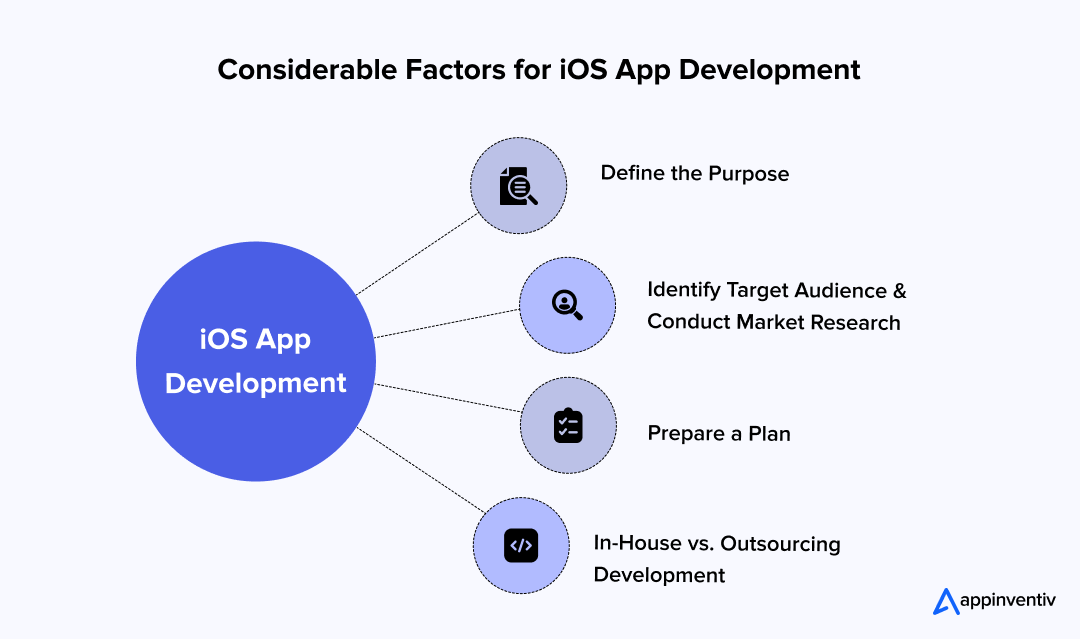
Define the Purpose
As the first step, it is important to define the purpose of developing the iOS app. You should be able to answer questions such as:
- Why do you want to develop a particular app?
- What is the problem you are trying to resolve through the app?
- Are there similar apps in the market? How is your app different?
- What are your success metrics?
- How will you monetize the app?
Identify Target Audience & Conduct Market Research
Define your target audience by conducting a thorough market research. Conduct surveys and try to create a consumer persona to identify the type of users you want to target. What are their demographics, behaviors, pain points, and preferences?
Conduct thorough market research to understand existing solutions, identify competitors, and pinpoint unique selling propositions for your app. Knowing your audience intimately is key to designing intuitive iOS application features that resonate.
Prepare a Plan
Once you have defined the purpose and identified your target audience, the next step includes planning. Be as detailed as possible and try to answer questions such as:
- What are your goals and objectives?
- What activities and features will run on the app?
- What is the price you are willing to pay for getting an iOS app developed?
- Which is the best iOS or iPhone app development language and technology?
- What security issues should be taken into account?
- How will you measure the success of the app?
- Do you wish to develop the versions of the iOS app on other operating systems?
- How will you overcome unforeseen challenges such us budget overrun?
Choose between In-house vs. Outsourcing Development
Many companies wonder whether to build the application in-house or outsource the development process. This is a critical decision.
| In-house Development | Outsourcing Development |
|---|---|
| Greater Control: Offers direct communication and control over the project. | Cost-effective: Access to a global talent pool and specialized expertise at a lower cost. |
| Requires Investment: Significant upfront costs to hire and retain a specialized iOS development team. | No Overheads: No need to manage team logistics, reducing overhead costs. |
| Management Overhead: Involves managing a team, overheads, and long-term commitments. | Flexibility & Scalability: Ideal for project-based needs, offering flexibility to scale as required. |
| Long-Term Commitment: Requires a sustained investment in talent and resources. | Specialized Expertise: Enables access to skilled professionals for specific needs. |
Expert Insight: To remain competitive in the global marketplace, it is recommended to outsource the development services as it ensures the best possible product with reduced costs.
How to Build iOS Apps for Business – A Step-by-Step Process
Building a successful iOS app is more than just coding; it’s a strategic journey that demands foresight, agility, and a deep understanding of your users. You need a clear vision, meticulous planning, expert execution, and constant refinement. Here are some essential iOS app development steps.
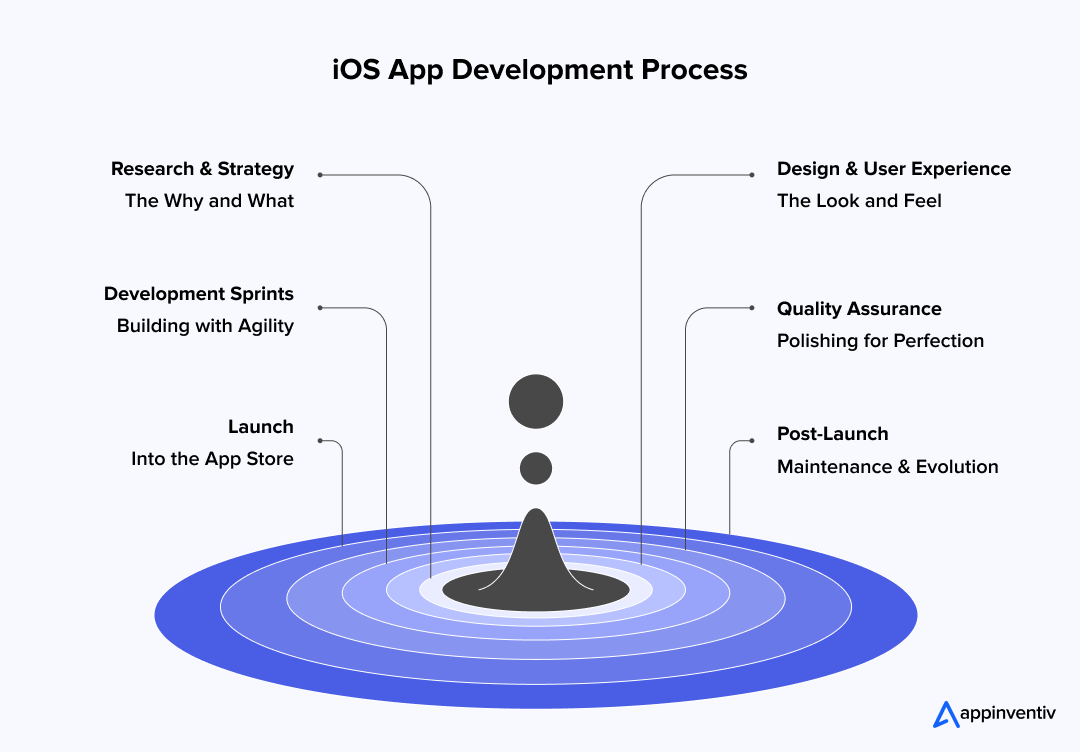
Research & Strategy: The Why and What
Before writing a single line of code, start by defining your app’s core purpose and what makes it stand out. This means diving into market research, understanding your audience’s needs and pain points, and outlining the key features for your Minimum Viable Product (MVP). The goal here is to make sure that your custom iOS app development addresses a real problem and fits with your overall business goals, laying a solid foundation for everything that comes next.
Design & User Experience: The Look and Feel
In this phase, your idea starts to take shape, both visually and interactively. The design process includes the following steps:
- Wireframing: Once the concept behind the application is clear, the next step includes documenting the requirements for the design team. The team then develops wireframes – digital sketches of how the app would look.
- UI/UX design: The main objective at this stage is to craft an intuitive UI/UX design that is not only visually appealing but also easy to use.
- Software architecture: It includes three important components of the model-view-controller (MVC) paradigm – data, user, and software. This step ensures the scalability and stability of the app.
Also Read: Android vs iOS: App UI Design Difference and Comparison
Development Sprints: Building with Agility
This is the most critical phase of the iPhone app development as it is all about bringing the idea into reality. This stage has three different important parts:
- Backend Development: Building the server-side logic, databases, and systems that power your app’s functionality.
- Application Programming Interfaces (APIs): Creating seamless connections between the app and external services or databases for smooth data exchange.
- Frontend Development: Designing and coding the user interface, ensuring a smooth and engaging experience for the app users.
Quality Assurance: Polishing for Perfection
Before your app hits the App Store, thorough testing is crucial. This includes everything from unit testing to integration testing, performance testing, and User Acceptance Testing (UAT) with real users via tools like TestFlight. The goal is simple: eliminate bugs, optimize performance, and make sure your app is secure, reliable, and ready to shine in the hands of users.
Launch: Into the App Store
Once your app is ready, the next step is submitting it to the App Store. This crucial phase involves making sure your app meets Apple’s approval guidelines, covering everything from functionality to design and security. With thorough checks and final adjustments, your app is set for a smooth launch, ensuring it adheres to Apple’s strict standards for quality and user experience.
Post-Launch Maintenance & Evolution
The journey doesn’t end with launch. Post-launch maintenance is vital to ensure your app remains functional, secure, and competitive. This phase includes regular updates, bug fixes, and the addition of new features based on user feedback and evolving market trends. Staying responsive and flexible is key to keeping your app aligned with user expectations and maintaining performance.
From Concept to Success: Tackling iOS App Development Challenges
Developing for the iOS ecosystem can be incredibly rewarding, but it comes with its own set of challenges. Navigating these obstacles requires foresight and well-thought-out strategies to ensure a smooth and successful project. Understanding these challenges in iOS app development is crucial to achieving a strong and lasting outcome.
Adhering to Apple’s Strict Guidelines
Challenge: Apple has strict App Store Review Guidelines and Human Interface Guidelines (HIG) that cover everything from design and functionality to privacy and security. Failing to meet these guidelines can result in your app being rejected.
Solution: Start by thoroughly reviewing the latest guidelines. Collaborate with experienced UI/UX designers and iOS app developers who are well-versed in Apple’s ecosystem. This ensures that your app follows “design-by-guideline” and “privacy-by-design” principles from the very beginning.
Ensuring Device Fragmentation
Challenge: While iOS is less fragmented than Android, there are still various device models, screen sizes (from iPhones to iPads), and operating system versions to consider. This variability can impact testing and optimization.
Solution: Use responsive design principles like Auto Layout and SwiftUI to make sure your app adapts well across different devices and screen sizes. Make testing on a wide range of devices and iOS versions a priority to guarantee a consistent experience for all users.
Managing Performance and Battery Drain
Challenge: iOS users expect apps to be fast and energy-efficient. Slow performance, long load times, or excessive battery drain can lead to uninstalls and negative reviews.
Solution: Optimize your code for better performance, take advantage of Apple’s performance tools (like Instruments), and manage network requests and background processes carefully. Regular performance profiling will help ensure your app runs smoothly and efficiently.
Data Security and Privacy Concerns
Challenge: With Apple’s strong focus on privacy (like App Tracking Transparency), maintaining data security and transparent privacy practices becomes a real challenge.
Solution: Leverage Apple’s built-in security frameworks, such as Keychain and Data Protection API. Adhere to data minimization principles, provide clear privacy policies, and comply with global data protection regulations like GDPR.
By proactively addressing these common challenges in iOS app development, businesses can create high-quality, secure, and scalable apps that resonate with iOS users and stand the test of time.
Beyond the Basics: Core Features for iOS Applications That Engage
When it comes to iOS app development, the basics—such as smooth functionality and intuitive design—are essential, but to truly engage users, your app needs to offer more. The most successful iOS apps go beyond just meeting user expectations; they provide an experience that resonates with their audience and encourages continued interaction. Here are some core features that can take your iOS app from good to great:
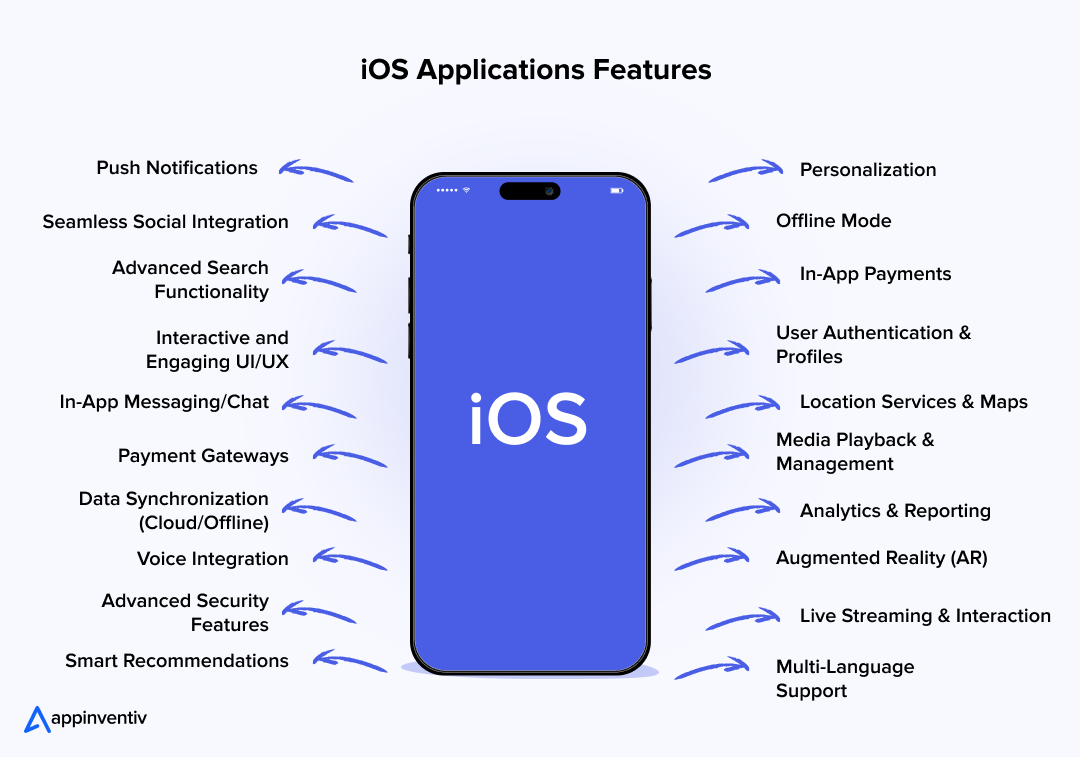
Push Notifications: Keep users engaged by sending timely, relevant updates, reminders, and personalized offers, helping drive re-engagement without overwhelming them.
Personalization: Customize the user experience based on their behavior, preferences, or location. Personalized content, product recommendations, or themes make the app feel more tailored to individual needs.
Seamless Social Integration: Let users easily share content, achievements, or experiences on social media platforms, increasing visibility while offering them a sense of connection with their social circles.
Offline Mode: Ensure your app is useful even without an internet connection. By offering offline functionality, users can interact with the app and access key features anytime, anywhere.
Advanced Security Features: Integrate biometric authentication (Face ID/Touch ID), end-to-end encryption, and secure data storage to ensure that user information is safe and protected.
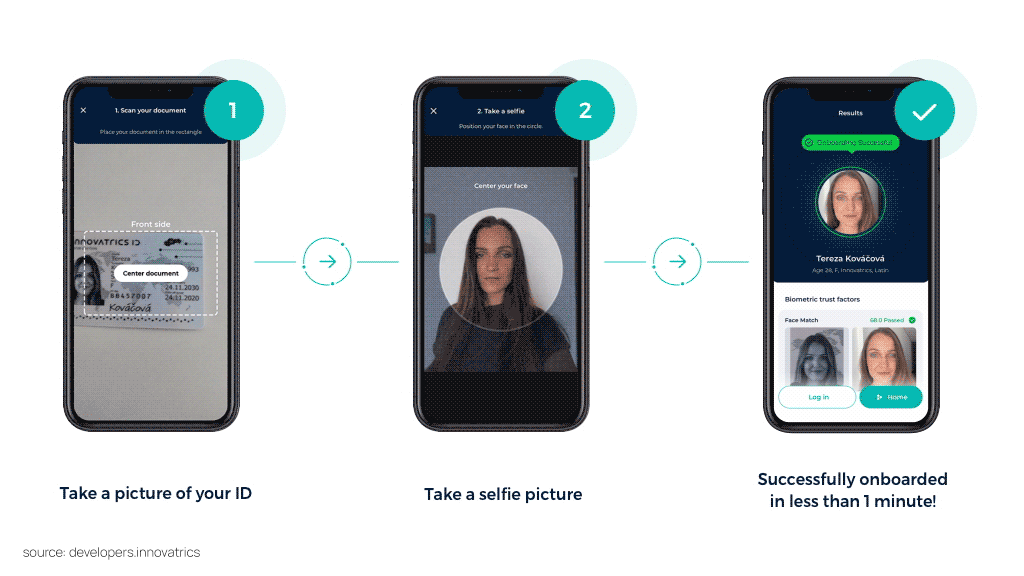
Advanced Search Functionality: A powerful, intuitive search system with filters and smart suggestions can dramatically improve user experience, helping users find exactly what they’re looking for with minimal effort.
In-App Payments: Providing an easy, secure method for users to make purchases or subscriptions directly through the app streamlines the user journey, adding convenience and promoting monetization.
Interactive and Engaging UI/UX: Simple animations, smooth transitions, and user-friendly interfaces not only make the app visually appealing but also enhance usability, encouraging longer app usage and retention.
User Authentication & Profiles: Secure login options like email/password, social media accounts, and biometric features such as Face ID/Touch ID enhance security while offering a seamless, personalized user experience.
In-App Messaging/Chat: Enable direct communication within the app, whether for customer support, peer-to-peer interaction, or building a community around your brand.
Location Services & Maps: Integrate GPS functionality for features like navigation, proximity-based services, location tagging, or finding nearby points of interest, enhancing the app’s utility.
Analytics & Reporting: Integrate tools to track user behavior, app performance, and key metrics, giving you valuable insights to continually improve the app and enhance user engagement.
Voice Integration: Enhance hands-free interaction by incorporating voice commands, Siri integration, or custom voice assistants, allowing users to navigate and interact with the app using voice alone.
Augmented Reality (AR): Leverage AR for interactive and immersive experiences, such as virtual try-ons, product demos, or mapping features that bring new levels of engagement to your app.
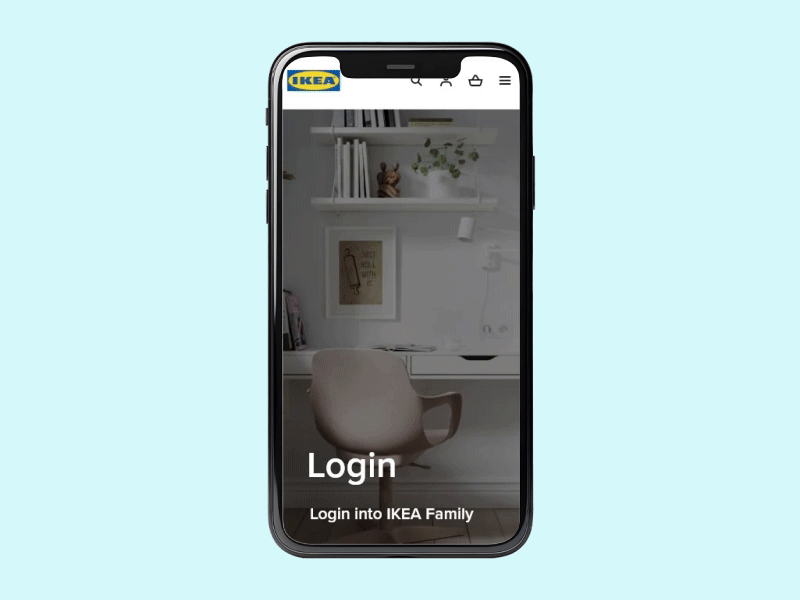
Payment Gateways: Ensure secure transactions with Apple Pay, credit/debit card processing, and third-party payment solutions for in-app purchases, subscriptions, or e-commerce.
Media Playback & Management: Enable users to stream audio/video, manage photo galleries, and even record or edit media within the app for a richer, more interactive experience.
Data Synchronization (Cloud/Offline): Sync user data across devices via iCloud or custom backends, allowing for smooth transitions between devices and offline access when necessary.
Live Streaming & Interaction: Enable live video streaming with user interactions like comments, likes, or reactions to foster engagement and real-time communication.
Smart Recommendations: Use AI-driven algorithms to provide personalized suggestions based on user activity, ensuring your app’s content or products are always relevant to the individual.
Multi-Language Support: Expand your app’s reach by including multiple languages, offering a more inclusive experience for users across different regions.
What Is the Cost of iOS App Development?
On average, iOS mobile app development cost ranges between $40,000 and $500,000 or more. However, it is not a fixed price. The actual investment is influenced by several factors such as project complexity, tech stack selection, etc. In short, it is much like building a house – the bigger and more complex, the higher the cost.
Here are a few factors to consider while deciding your iOS app development budget:
- Size of the app: The size of the app directly impacts the development cost. When the app size increases, so do the features, resulting in higher development time and cost.
- Complexity of the features: The iOS app development cost is impacted not just by the number of features but also by the complexity of features in an app.
- UI/UX cost: Various app designs take different numbers of hours to complete and thus have different costs
- Native or cross-platform: There are two approaches to iOS app development – native and cross-platform. The costs of a cross-platform app are generally higher as they are deployed on both the PlayStore and iOS.
- App testing: Testing is one of the most important aspects of any mobile app development as it ensures optimum performance, security, and other factors. There are various types of iOS app testing, which impact the overall cost of development.
Here is a table outlining an estimated cost range of iOS app development based on the project’s complexity.
| App Type | Price Range | Description |
|---|---|---|
| Simple Apps (MVP) | $40,000 – $90,000 | Basic utility apps, static content apps, or information portals. |
| Medium Complexity Apps | $90,000 – $150,000 | E-commerce apps, booking apps, or social apps with standard features and a backend. |
| Complex Apps | $150,000 – $300,000+ | On-demand services, advanced gaming apps, or enterprise solutions with intricate design and custom integrations. |
| Highly Complex/Enterprise-Grade Apps | $300,000 – $500,000+ | Large-scale, highly complex apps with advanced features and integrations. |
To have a rough estimate of the average cost required to develop an iOS app, you can use the following formula:
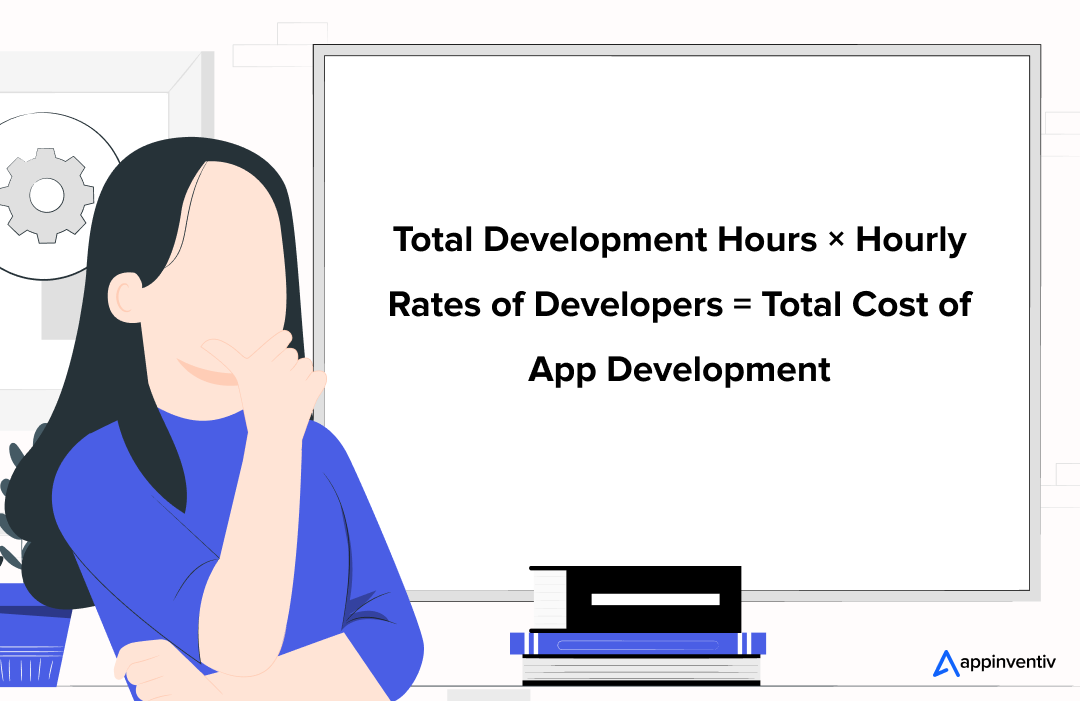
How to Optimize Your iOS Mobile App Development Cost
Developing an iOS app can be a significant investment, but with the right approach, you can optimize your budget efficiently. However, optimizing your iOS app development cost doesn’t mean sacrificing quality; it means making smart, strategic decisions throughout the entire process. By focusing on efficiency and value, businesses can launch a high-performing app without overspending. Here are key strategies to consider for cost-effective development:
- Start with an MVP: Launch with essential features first, gather feedback, and then iterate. This significantly reduces initial costs and allows for market validation.
- Prioritize Essential Features: Prioritize what’s truly essential for your initial launch. Every feature adds to the complexity and, consequently, the cost of developing iOS apps.
- Consider Cross-Platform: For less complex apps, hybrid development using frameworks like Flutter or React Native can offer cost savings by using a single codebase for both iOS and Android.
- Outsource Strategically: Partnering with an experienced and reputable mobile app development services provider can offer a better cost-to-value ratio, especially with offshore teams.
iOS App Development Trends to Consider in 2022 & Beyond
Mobile apps are a competitive market, and you need to be aware of the key trends in iOS app development to have a futuristic approach to strengthen the app. Staying abreast of these trends is essential for building a forward-thinking and competitive application. Here are the top iOS app development trends to watch out for:
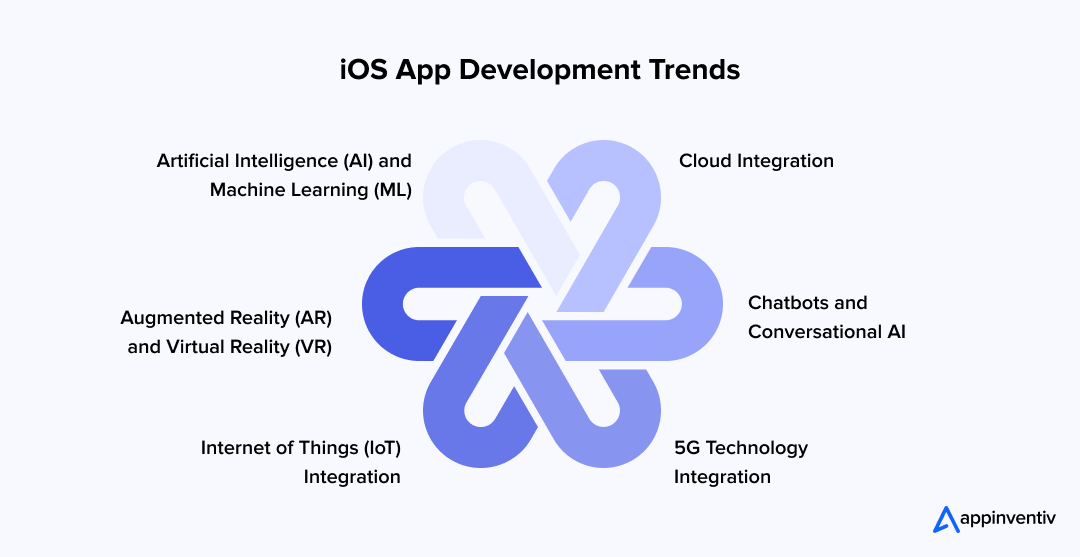
Artificial Intelligence (AI) and Machine Learning (ML)
AI and ML are no longer futuristic concepts; they’re integrated into everyday apps. For iOS, Apple’s Neural Engine and Core ML make on-device AI powerful. This enables personalized experiences, advanced AI analytics, intelligent recommendations, and advanced image/voice recognition. This enhances user engagement and app efficiency without compromising privacy.
Example: Smart assistants, personalized content feeds, fraud detection, and predictive typing.
Augmented Reality (AR) and Virtual Reality (VR)
Apple’s ARKit has made AR a significant player on iOS. Businesses are leveraging AR for immersive shopping experiences (e.g., trying on clothes virtually), interactive product visualization, gaming, and even practical tools for measurements and design. With the introduction of Apple Vision Pro and visionOS, spatial computing has become a new tech trend for immersive applications.
Example: IKEA furnishing app, Snapchat filters, virtual tours.
Internet of Things (IoT) Integration
As more devices become “smart” (wearables, home appliances, industrial sensors), iOS apps are becoming central hubs for controlling and interacting with them. IoT-enabled apps for iOS easily connect with smart wristwatches, bands, and other wearable devices.
Smart home control apps, fitness trackers integrated with health apps, and industrial monitoring solutions.
Cloud Integration
Cloud technology promises to bring a lot of opportunities to the iOS app development industry. Cloud computing in businesses (AWS, Azure, Google Cloud, iCloud) provides scalable backend infrastructure for iOS apps, handling data storage, processing, and synchronization. This ensures apps can manage large user bases and complex data operations efficiently and securely.
Example: Seamless data sync across devices, collaborative apps, and large-scale data analytics.
Chatbots and Conversational AI
Integrated chatbots provide instant customer support, answer FAQs, and guide users through processes, enhancing user experience and reducing the burden on human support teams. Advances in conversational AI make these interactions more natural and helpful.
Example: In-app customer service bots, virtual assistants for tasks.
5G Technology Integration
The rollout of 5G networks in mobile apps enables faster data speeds, lower latency, and greater bandwidth. This facilitates richer, data-intensive types of mobile apps for the iOS platform, such as high-quality video streaming, real-time gaming, and more complex AR experiences.
Example: Ultra-high-definition video calls, real-time multiplayer games.
How to Choose an iOS App Development Company?
To build a successful iOS application, you must hire a reliable app development company that has a proven track record of building successful iOS and iPhone apps. However, with countless options available in the industry and all claiming to be the best, it is not an easy feat to find a trusted tech partner that delivers exactly what you expect. Here are some quick tips to hire the right iOS mobile app development company:
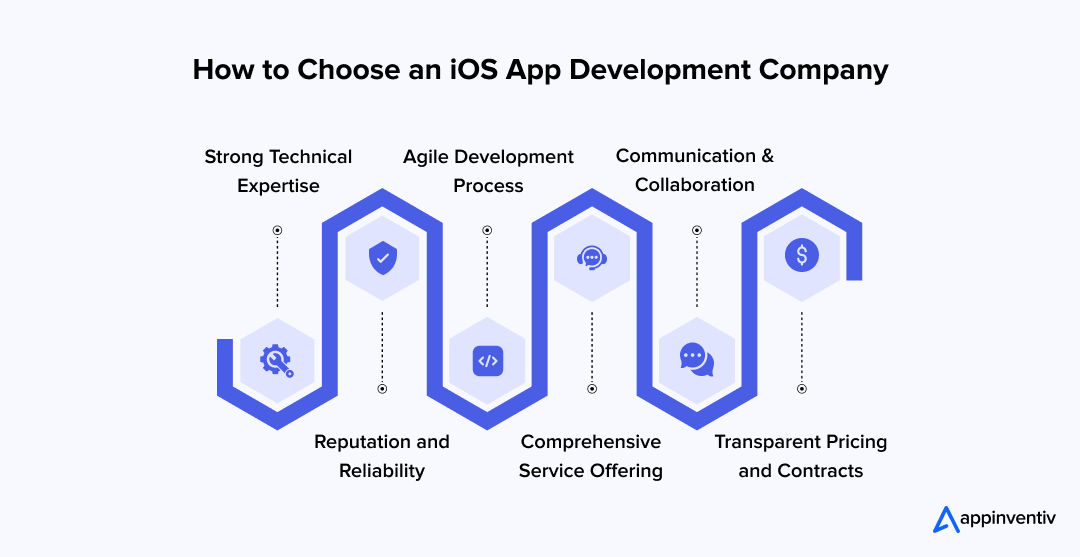
Strong Technical Expertise
The foundation of any successful app lies in the development team’s technical prowess. Ensure the company’s developers possess deep knowledge of the iOS ecosystem and can translate complex requirements into robust solutions.
- iOS Specialization: Proven track record in iOS application development, including Swift and Xcode.
- Portfolio: Diverse past projects showcasing quality in custom iOS app development.
- Tech Stack Knowledge: Expertise in relevant backend technologies and cloud platforms is crucial for key technologies for iOS app development.
Reputation and Reliability
It is essential to verify the company’s reputation in the marketplace. Checking the ratings and reviews of a company is a good way to understand the market reputation of a company. You can also try to figure out the following facts about a company to judge its reputation:
- Client Testimonials & Reviews: Look for honest feedback on platforms like Clutch, GoodFirms, or even direct client references.
- Case Studies: Do they provide detailed case studies that outline their process, challenges overcome, and results achieved for previous clients?
- Industry Recognition: Any awards, certifications, or thought leadership in the mobile development space?
Agile Development Process
An Agile development methodology ensures flexibility, transparency, and continuous feedback integration throughout the development lifecycle. This approach is customer-centric, allowing for adaptability even in later stages.
- Transparency: Clear communication channels and regular updates.
- Agile Methodology: Adherence to practices like scrums and sprints for iterative development.
- Project Management: Use of effective tools (e.g., Jira, Trello) for predictability and efficiency.
Comprehensive Service Offering
Beyond just coding, a truly valuable partner offers end-to-end support throughout your app’s lifecycle. Evaluate if they provide a holistic range of services to meet your needs from conception to post-launch.
- Full Lifecycle Support: Services from strategy and design to testing and QA, deployment, and post-launch support and maintenance.
- Dedicated Team: Assurance of a consistent project manager and development team.
- Quality Assurance & Security Practices: Rigorous testing procedures and strong security protocols for key aspects of iOS app development.
Communication and Collaboration
Effective communication is the cornerstone of any successful outsourced project. Ensure your potential partner is responsive, clear, and proactive in their interactions.
- Clear Communication: Responsive and articulate communication; insightful questions about your iPhone app development vision.
- Cultural Fit: Compatibility that enhances collaboration and the overall process.
Transparent Pricing and Contracts
Clear financial terms and well-defined contractual agreements prevent misunderstandings and build trust. Ensure all costs and deliverables are explicitly outlined.
- Transparent Pricing: Detailed breakdown of all iOS app development costs, avoiding hidden fees.
- Contract Clarity: Explicit outline of deliverables, timelines, payment schedules, and intellectual property rights.
By diligently vetting potential partners against these criteria, you can find a company that not only understands how to create iOS apps but also aligns with your business vision and values.
How Appinventiv Helped Global Brands Build High-End iOS Applications?
At Appinventiv, we pride ourselves on transforming innovative business ideas into impactful iOS applications. In our 10+ years of industry experience, we have helped many global brands achieve desired results through best-in-class mobile apps.
Here are a few examples of how we’ve helped businesses leverage the power of custom iOS app development:
We helped the largest pizza chain, Domino’s, by redesigning its app through a transformative UI/UX strategy. The result? 23% improvement in conversion rate.
We helped the retail giant, Adidas, expand its digital presence globally by developing an end-to-end Android and iOS application for its Middle Eastern market. Our efforts led to 2 million app downloads and 500K new users for the brand.
We helped DiabeticU build a secure, scalable, and HIPAA-compliant diabetes management app. This application for iOS and Android phones empowered users with AI-powered wellness recommendations and better self-management. This demonstrates how iOS mobile app development can create meaningful applications with complex functionalities that genuinely improve lives.
We helped an innovative eyewear company, Vyrb, develop a social media application that allows users to do voice posting on social media platforms using Bluetooth wearables. The result? $1 million funding for the app.
For the global fast-food giant, KFC, we developed a robust food delivery app for iOS and Android. Our effort let the brand witness 22% increase in the conversion rate, a 60% increase in repeat purchases, and over 50% of total orders started coming directly through the KFC mobile applications, reducing the reliance on aggregator apps.
This is just a glimpse of how Appinventiv’s mobile app development services have helped global brands create impactful iOS applications. We’ve developed countless custom apps from scratch and revamped the existing ones with new features, assisting businesses to drive success across various industries. To see more of how we’ve helped companies thrive, check out our full portfolio.
Accelerate Your iOS App Development Journey with Appinventiv Now
With over 3000+ successful projects and a team of 1600+ iOS app developers, Appinventiv stands as a leading iOS mobile app development company. Our clients’ testimonials speak to our proven track record of delivering innovative, high-performance apps that drive real business results. Backed by prestigious awards like Deloitte’s Tech Fast 50 Awards in 2023 & 2024, Times Business’ Tech Company of the Year 2023, etc., our commitment to building fully compliant products ensures that we maintain the highest standards of quality, security, and user experience.
Our agile approach ensures that each app we create not only meets your business needs but also exceeds expectations, helping you stay ahead in a fast-evolving digital landscape.
Partner with us now and see your business thrive in the lucrative iOS mobile app development landscape.
FAQs
Q. What is iOS app development?
A. iOS is Apple’s mobile operating system (OS) that runs on hardware including iPhone, iPad, and iPod Touch. An iOS application is programmed in languages such as Swift and Objective-C and then deployed to the App Store for users to download.
Q. Why go for iOS mobile app development?
A. The top Benefits of iOS app development for your business include:
- Better customer experience
- Higher ROI
- Enhanced security
- Better brand value
- Great compatibility
Q. How much does iPhone app development cost?
A. The iOS app development cost varies significantly based on various factors like app complexity, features, design intricacy, and the development team’s location and experience.
On average, iOS app development costs ranged from $40,000 to $500,000 or more, depending on your unique project requirements.
To get a more precise estimate for iOS app development costs, discuss your project idea with us and get a tailored quotation.
Q. What is the timeline for iOS app development?
A. The timeline for iOS app development typically ranges from 4 months to 1 year or more, depending on the app’s complexity, features, design requirements, and the expertise of your iOS app development company. Simple apps may take less time, while more complex apps with custom features, integrations, and detailed testing could take longer development time.
Q. Which languages are best for iOS app development?
A. For native iOS apps, Swift and Objective-C are the best programming languages. If you wish to create a hybrid iOS application, languages such as C# and HTML5 are considerable options.
Q. Is it better to outsource app development?
A.Outsourcing the mobile app development is a recommended option as it is both a cost-effective and risk-free approach. An outsourced iOS app development company is responsible for the entire workflow and provides support even after the application is deployed.
Q. How to outsource iOS app development?
A. Some tips to keep in mind while outsourcing the app development include:
- Know Your Requirements: Clearly define your app’s goals, features, and functionality.
- Check Expertise: Ensure the outsourcing company is well-versed in the latest iOS technologies and tools.
- Ensure Effective Communication: Ask questions to gauge their communication process and ensure seamless collaboration.
- Set Clear Expectations: Establish a mutual understanding of project timelines, deliverables, and quality standards.
- Request a Project Plan: Make sure they provide a detailed project roadmap outlining key milestones.
- Plan the Project Cost: Agree on the budget and payment structure to avoid any surprises later on.
Q. What are the best monetization strategies for iOS apps?
A. Common and effective monetization strategies for iOS apps include:
- In-App Purchases: Selling virtual goods, premium content, or additional features within the app.
- Subscriptions: Offering access to premium content or features on a recurring basis (e.g., monthly, annually).
- Freemium Model: Offering a basic version of the app for free and charging for advanced features or an ad-free experience.
- In-App Advertising: Displaying ads within the app (banner ads, interstitial ads, video ads).
- Paid Apps: Charging an upfront fee for the app download (though this is less common now, as the vast majority of iOS apps are free to download).
- Affiliate Marketing: Promoting products or services from other businesses within your app and earning a commission on sales or leads.
Q. What legal considerations should I be aware of when launching an iOS app?
A. Launching an iOS app involves several crucial legal considerations to ensure compliance and protect your business:
- Intellectual Property (IP) Rights: Ensure you own the app’s code, design, and content. Have clear agreements with developers regarding IP assignment.
- Privacy and Data Protection: Comply with regulations like GDPR (Europe), CCPA (California), and other regional data privacy laws. This includes transparent data collection practices, user consent, and secure data handling. Apple’s strict privacy guidelines (e.g., App Tracking Transparency) are paramount.
- Terms of Service (ToS) and End User License Agreement (EULA): These legal documents define the rules for using your app, user responsibilities, limitations of liability, and content usage policies.
- App Store Guidelines Compliance: Strict adherence to Apple’s App Store Review Guidelines is mandatory for approval and continued presence on the store. These cover content, functionality, performance, and security.
- Accessibility: Ensure your app is accessible to users with disabilities, complying with relevant accessibility standards.
- Advertising and Marketing Practices: If your app includes advertising, ensure it complies with relevant advertising laws and regulations.
Q. What is the best tech stack for my iOS app?
A. The “best” tech stack depends on your specific app’s requirements, complexity, and desired performance.
For Native iOS App Development
- Languages: Swift (primary choice), Objective-C (for legacy projects).
- UI Frameworks: SwiftUI (modern declarative UI) or UIKit (traditional imperative UI).
- IDE: Xcode.
- Backend (Optional, depending on app needs): Node.js, Python (Django/Flask), Ruby on Rails, Java (Spring Boot), .NET.
- Databases: PostgreSQL, MySQL, MongoDB, Firebase.
- Cloud Platforms: AWS, Google Cloud Platform, Microsoft Azure, iCloud.
For Cross-Platform (Hybrid) iOS App Development
- Frameworks: Flutter (Dart), React Native (JavaScript/TypeScript), Xamarin (C#).
- Backend, Databases, and Cloud Platforms: Similar options as native development.
Q: What are some top iOS application features?
A: Some top iOS app features include:
- Push Notifications: Keep users engaged with timely updates and alerts.
- In-App Purchases: Allow users to buy content or premium features directly within the app.
- Face ID/Touch ID: Enhance security and user experience with biometric authentication.
- Offline Functionality: Enable users to access key features even without an internet connection.
- GPS Integration: Provide location-based services, maps, and directions.
- Camera Integration: Allow users to take photos, scan QR codes, or record videos directly within the app.
- Apple Pay: Offer secure, seamless payment options directly through the app.
- Customizable UI: Enable personalized user interfaces based on preferences and behaviors.
- App Analytics: Track user interactions, behavior, and app performance to make data-driven decisions.
- Social Media Integration: Allow users to easily share content or log in via social platforms like Facebook, Twitter, etc.


- In just 2 mins you will get a response
- Your idea is 100% protected by our Non Disclosure Agreement.
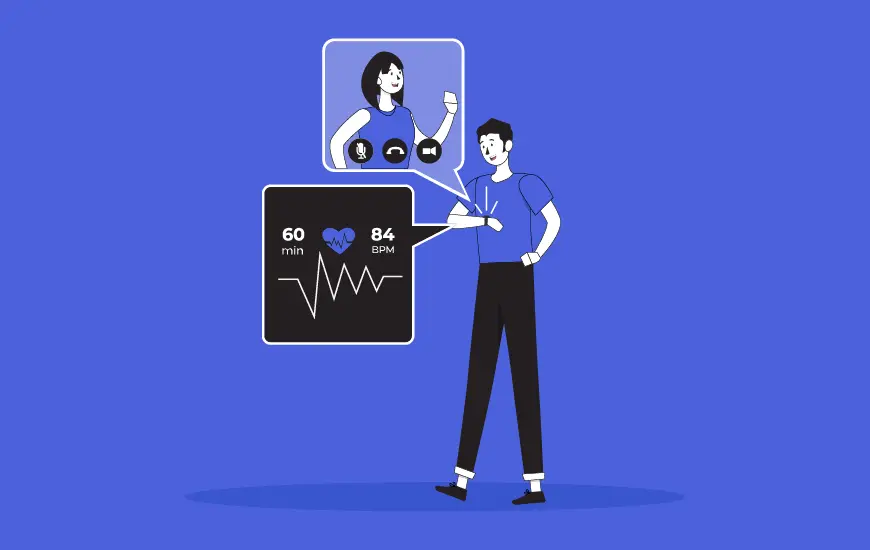
When Google acquired Fitbit for $2.1 billion in 2021, it was not just buying a fitness tracker but investing in a thriving ecosystem powered by wearable apps. Fitbit’s success was not just about hardware; its app’s ability to deliver real-time health insights, sync seamlessly with multiple devices, and engage users with personalized recommendations made it…

In today’s digital age, having a strong online presence is the key to unlocking the door of business transformation and reaching the target audience. One of the most efficient ways to achieve this is through web app development. Web applications have grown at an unprecedented pace in the past decade, revolutionizing operations across various industries.…
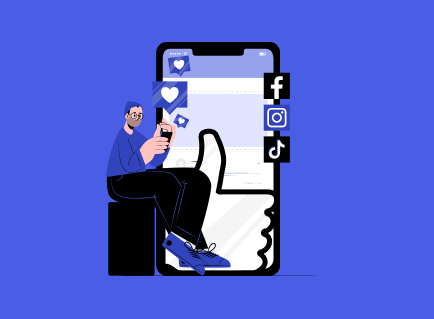
Key takeaways: With 6.05 billion users expected by 2028, social media apps are growing fast, creating opportunities for new entrants. Essential and advanced features for social media apps include profiles, feeds, media sharing, messaging, notifications, security, AR filters, and analytics. AI-driven personalization, social commerce, and AR/VR experiences are some of the emerging trends in social…
